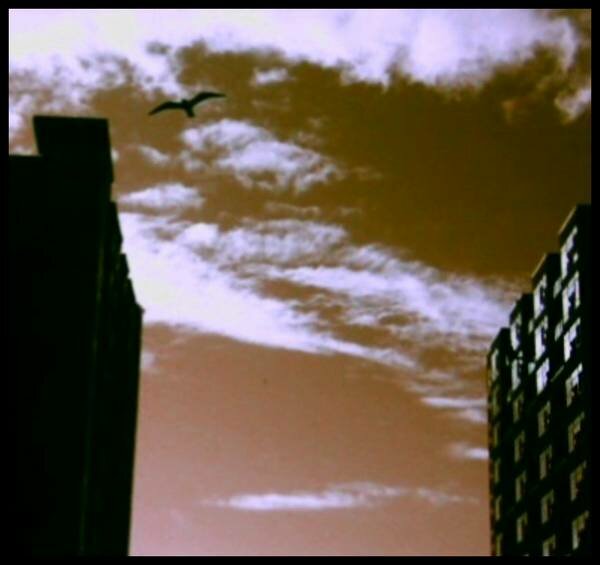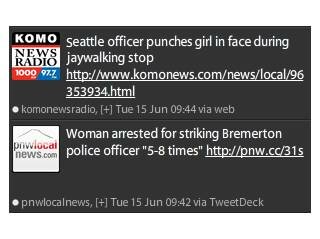A guerilla "Seattle Times" front page found downtown.
What we have here is a failure to communicate.
"If there's borderline criminal or suspicious activity, I say let it go," union president Sgt. Rich O'Neill told Seattle Times columnist Danny Westneat. "Don't go out on a limb. It's not worth it, because if it goes sideways, you're going to be the latest poster child on the news."
This passive-aggressive response is due at least in part to the fate of officer Ian Birk, who resigned from the police force after his shooting of John T. Williams was ruled unjustified by the Firearms Review Board. The Board simply could not make sense of discrepancies between Birk's behavior and his after-the-fact testimony.
With backup only 20 seconds away, Birk emerged from his patrol car alone to contact a "suspicious person," so far as dispatch knew. Yet his service sidearm was drawn and in a "low-ready" position. He closed distance on Williams, failed to identify himself as a police officer while ordering Williams to drop his knife, and ended up shooting Williams to death, all in a matter of seconds.
With deference to O'Neill, I want to suggest that--despite all these mistakes or lapses in judgment--had Birk not shot a man to death in the street, he would not have been the latest poster child on the news. That is the takeaway here. Few expect police to be perfect, and a police officer is generally given the benefit of the doubt. People know it's not easy wearing blue; we all read about officers getting jumped and choked in the line of duty. ...
John T. Williams has less than 30 seconds to live in this picture.
At the ongoing inquest into the August 30, 2010, shooting death of Native American wood carver and (I think it's fair to say) chronic alcoholic John T. Williams, officer Ian Birk has testified that he had "no doubt in my mind that an attack was coming" based on his reading of Williams' body language and face (clenched jaw, thousand-yard stare).Today, witnesses who were in the area are testifying that they did not perceive Williams as aggressive, so much as Birk. At Seattlepi.com, you read that "Birk testified he thought the incident would end with a conversation, but 'it became pretty serious pretty fast.'"
In the video below, taken from the dashboard camera of Birk's patrol vehicle, you can see Williams making his way across the street, in a crosswalk, at 51 seconds in. Birk exits his vehicle and crosses in front of it at 1:03, some twelve seconds later. He's walking with speed and his gun appears to be out and in his hand. So while it is not clear how he thought the conversation would go, the situation seems to have become serious to him very early on, before confronting Williams....
The news about the Native American man who was shot to death after being found wood-carving in public continues to "develop," as they say. Now it is not clear that he approached the officer threateningly or otherwise, and his family says he was deaf in one ear.
The Seattle Times says Mayor McGinn, "despite several controversial police incidents this year" is confident in his choice of Police Chief Diaz.
"I think Chief Diaz is the right man for the job," McGinn is quoted saying, which has overtones of "Heckuva job, Brownie," coming the same week as King County prosecutors decided that a police officer who told an innocent Latino man he was going to "beat the fucking Mexican piss" out of him was not guilty of a hate crime. The city attorney could still file charges against Detective Shandy Cobane for misdemeanor assault, further endearing himself to the SPD.
McGinn's political deafness has instigated a completely avoidable kerfluffle with MOHAI. Yesterday the Slog reported that the city was making a grab for state funds allocated for MOHAI's SR 520-prompted move from its Montlake location to the South Lake Union Armory.
After directing the museum to negotiate on its own for state funds, estimated to be around $15 million, the city's cartoon eyes exploded from its face when MOHAI came back with $40 million. Quoth Carl Marquardt, lead attorney for the mayor’s office: "This is not a time for any one community organization to be taking all that it can get, while others go without."...
Do not think about heading to Downtown right now, unless you're going on foot. And if you're already Downtown, well, you're gonna be there a while. A Seattle police officer shot and killed a man armed with a knife near the intersection of Boren and Howell, so several streets are shut down, meaning traffic and buses are being re-routed. It is not pretty.
(Thanks as always to Seattle 911 blog for being a reliable go-to resource in just these situations.)
 Thanks to our Flickr pool's shawnmebo for illustrating that Belltown can be beautiful.
Thanks to our Flickr pool's shawnmebo for illustrating that Belltown can be beautiful.
Last night Mayor McGinn and I'm-official-now Police Chief John Diaz had some squishy "news" to report in the battle to reclaim Belltown from drunken douchenozzles and menacing assmittens. A month and a half in, the pair claimed their Late Night Public Safety Initiative has "paid some huge dividends."
The Seattlepi.com quotes Chief Diaz saying, "We've stopped at least two shootings that I know of that were this close to turning into something very serious, we were able to stop the individuals."
For balance, the Seattle Times notes one woman complained that a morning walk to the store included "a pimp and a group of prostitutes, a drug dealer waiting for a buyer and a homeless man who was masturbating in a doorway."
Belltownpeople attended the public safety meeting, and notes that besides the increased police presence, Belltown will see once-a-week foot patrols, new LED streetlights, a drug-dealer and mentally unstable diversion program (which needs funding), and faster cleanup on Aisle 4, thanks to a CleanScapes pilot project....
It started innocently enough, with the Pothole Rangers' online form. See a pothole, report it online, and BLAMMO! pothole filled. If you've tried it, you know the weird feeling of power when it actually works, and a few days later there's fresh asphalt where once there was only hole.
But as the streets decay, that power becomes responsibility. Every pothole adds itself to a to-do list. Your to-do list. You look around. Is anyone else seeing something and saying something? And then, grouchily, you wonder if it's anyone's job at all anymore, at the City, to check for potholes.
With this perspective in mind, you may or may not be all that thrilled to learn that you can now also report malfunctioning street lights online, or report certain crimes (Property Destruction, Car Prowls, Auto Accessories, Theft of Property under $500, and Identity Theft).
The crime has to have happened in Seattle city limits, not be an emergency, and not come with known suspects. (If it's an emergency, you call 911, of course. If the crime is of another variety and not an emergency, you call 206-625-5011.) There are no rules for ratting out a street light--but helpfully, the map tells you if City Light is already working on the problem.
Government 2.0 was part of Mayor McGinn's campaign, and you can't say he hasn't followed through on it. Besides the emphasis on online reporting options, the City has also created Data.Seattle.Gov, a repository of datasets. The most highly ranked are active building permits and the location of city-maintained toilets, and crime statistics and a real-time 911 feed are there as well. Go ahead, browse. Here's Seattle's designated public fishing holes.
As it turns out, the plan from last September--"doing more with less," "democratizing data," and "revolutionizing community engagement" with the power of Seattle's "collective IQ"--is pretty much what we're seeing occur, if slowly, and with an emphasis of the "doing more with less" part. Who knew that civic engagement would be redefined as a proficiency with filling in online text boxes?
Seattle Police Chief John Diaz
This morning, Mayor McGinn announced interim police chief John Diaz would be taking over the position permanently. Diaz--a veteran with the department who began his SPD service in 1980--remarked that his selection sent a powerful message to the rank and file that someone who started as a patrol officer could work his or her way to the top. [UPDATE: Chief Diaz's full statement here.]McGinn began his remarks by saying that six months ago, Chief Diaz might not have been his first pick, but that through his experience working with Diaz, and seeing his response to the challenges the Seattle Police Department has faced, he felt sure Diaz was the best choice: "The issue here was who was best prepared to deal with the issues of public safety in the city." McGinn said another factor was the budget, and whether the new chief's policing strategy took into account doing more with less.
The press scrum at the announcement focused its questions on the department's sometimes testy relations with the NAACP and on whether Diaz represented the status quo. Diaz responded that the SPD is known nationally for its progressive policing, and that, yes, the SPD had work to do improving its image in minority communities.
In retrospect, Publicola had it right. A few days ago, McGinn and Diaz appeared together to announce a high-profile policing response to the recent spate of Belltown violence.
Asked whether Diaz's place at his side today indicated that he had made up his mind, McGinn responded, "We will have an announcement when we have an announcement."
 The Seattle Police Department spent much of last week in the center ring of the media circus surrounding a jaywalking bust gone bad, and I couldn't shake the feeling the brass's eye had wandered off the ball.
The Seattle Police Department spent much of last week in the center ring of the media circus surrounding a jaywalking bust gone bad, and I couldn't shake the feeling the brass's eye had wandered off the ball.
As if to underscore that, Belltown saw another weekend shooting (June 6: shooting death of Steven Sok outside Belltown's V-Bar; June 13: the "shots fired" weekend), and one man was beaten unconscious. He'd confronted four men who were making catcalls at his girlfriend.
Belltown has been on a roll this spring: An end-of-May brawl saw 20 to 30 people fighting in the street.
Belltown People compares the post-last-call scene to Clockwork Orange's "ultraviolence":
Nearly every shooting, mugging, bludgeoning, and assault takes place after the neighborhood's clubs herd their drunken patrons onto the street. Neighbors are rightly concerned at the apparent inability of the police department to cope with such a serious onslaught of drunken hooligans....
The video of a Seattle police officer striking an uncooperative jaywalker is all over the news this morning. Punching a young woman in the face seems disproportionate to the crime of jaywalking, although you're not at liberty to tell the police to pound sand (in the parlance of earlier days) when they catch you doing it.
As it happens, my Twitter feed produced this counterpoint, for which no one has produced video: "Woman arrested for punching police officer in Bremerton." Multiple times. I don't mean to suggest that it's a question of punch-or-be-punched, but let's not pretend that police officers' jobs are any easier than they are, or that verbally abusing them and obstructing the process of their duty leaves you blameless. When people are behaving like jackasses, the rest of us can walk away shaking our heads, but police can't.
Most Viewed Stories
- Belltown NIMBYs Have a Problem With This Upstart "5 Point" Place
- From the Publisher's Couch: The SunBreak's Progress, Chapter Two
- Watch This Space! Live from New York, It's Spectrum Dance Theater
- The Weekend Wrap: Neighborhood Headline News Feb. 20 - 26
- "The New New News" Illustrates Hybrid Vigor of News-Theatre



Most Recent Comments